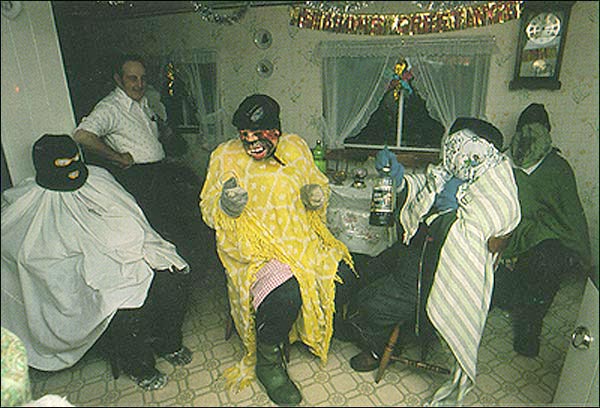Folklore and Traditional Culture
Only very rarely is folklore an heirloom passed along unchanged from parents to children over many generations. Folklore presents itself in a myriad of forms, all equally "original" and "correct." Each generation picks what it likes from its heritage, amplifying and modifying it to suit present needs. Individuals, too, have different tastes and thus folklore grows and changes over the years. The folklore and traditional culture of Newfoundland and Labrador is historically based in the traditional cultures of the peoples who settled the Province, but it also reflects the evolution of life here in all its complexities over the centuries of human occupation.
Origins of Folklore
Our folklore is similar in many details to folklore found in the parts of Ireland and England from where settlers emigrated over the past two or three centuries. For example, folktales and fairy beliefs were among the traditions brought over from England and Ireland. Dialect words sometimes derive from the dialects and languages of those areas. "Nuddick," a local word for a knobby hill, comes from a West Country English word. "Buckaloon" (meaning a self-important man) comes from an Irish word. But much local tradition is entirely of local origin -- Tipp's Eve (December 23rd) and the dance "Running The Goat" are examples.
Much also derives from the cultures of aboriginal peoples: the craft of skinboot-making and the word "pipsy" (sun-dried fish without salt, from Inuktitut), for example. The folklore of French Newfoundland overlaps with that of the rest of the province but has remained distinct through the 20th century, not least because of its linguistic independence.
The "Genres" of Folklore
The division of folklore and traditional culture into "genres" (like custom, belief and song) is an arbitrary one, reflecting not so much the traditions themselves as the need for scholars to divide them into manageable bits. It is useful to make these distinctions, but careful users will find many overlaps. For convenience of presentation, the folklore and traditional culture of Newfoundland and Labrador may be divided into eight genres:
Custom includes people's activities related either to the calendar (like Orangemen's Day parades, garden parties, and mummering), or to non-calendric events sometimes known as rites of passage (like weddings, first communions, and funerals).
Material Culture includes the tangible products of labour for necessity, pleasure or profit. This category includes buildings (like fish stores and root cellars), the landscape (like gardens or the arrangement of houses in a community) and objects (like fences or boats).
Belief includes folk medicine (cures for the "old hag", hangovers and warts, for example), supernatural beings (like fairies, the devil, and ghosts), and divination and causes (like forecasting the weather and breaking witches' spells).
Narrative includes all traditional story-telling like legends about local characters, treasure stories, and tales about "Jack" on his wondrous voyages. Explanations of placenames are included here, as are mythical stories like how the halibut got its name.
Song includes the rich body of folksongs known in this province, both the traditional ballads, some of which are centuries old, and the lively tradition of local songs (like "Lukey's Boat" and "I's the B'y").
Music includes the history of tunes, the musicians who played music and the instruments used (like accordions, violins and ugly sticks).
Dance includes both the steps used in Newfoundland and Labrador communities and the events at which people dance.
Small Genres include proverbs and proverbial phrases (for example, "he smokes like a tilt"), riddles (like "The wind was west and west sailed we..."), and blasons populaires (nicknames for groups of people (like Cape Broyle "wobbles" and Calvert "gatchers").
Scholarly Works About Folklore
Many scholarly works have been written about Newfoundland and Labrador folklore. An early, ground-breaking work was Christmas Mumming in Newfoundland (edited by George Story and Herbert Halpert and published by the University of Toronto Press for Memorial University of Newfoundland in 1968). Its essays looked at the history and distribution of Christmas customs in Newfoundland and set the stage for other important work.

In the early 1980s the Dictionary of Newfoundland English was published (Breakwater Press and University of Toronto Press, 1982; second edition 1990). The editors, William Kirwin, George Story, and John Widdowson, brought together thousands of words and phrases used in the province. It was a monumental scholarly work that broke new lexicographical ground by using oral sources as well as published ones in gathering words. It is also a starting point for much research in the culture of Newfoundland and Labrador.
In 1996 Herbert Halpert and John Widdowson's Folktales of Newfoundland was published, capping a research project that spread over a half-century of narrative collection in the Province. An international standard in folklore scholarship, it brings together dozens of internationally known and local folktales, some of which are hundreds of years old, and all of which were recorded in Newfoundland, with contextual information about the storytelling situations in which they were recounted.
A current bibliography of articles and books on Newfoundland and Labrador traditional culture would amount to over a thousand entries (one published in 1989 listed 950 entries dealing with folklore and language). An active department of folklore and a large Folklore and Language Archive are established at Memorial University of Newfoundland in St John's (email: munfla@mun.ca) and current research continues on many fronts.




